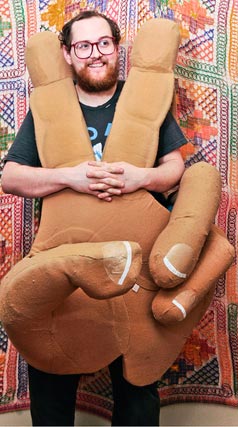Hi Hannah! You popped up on my radar at Noise Theory around 18 months ago, and from there I’ve watched you flit between (seemingly) a zillion projects, both in Brisbane and abroad. Come, tell us: who are you, and what do you do?

I’ve figured that there will be two main details about me which are more relevant to your readers:
a) I am the student representative and event coordinator for the Queensland committee of the Australian Interactive Media Industry Association (AIMIA), and
b) I am the founder of Brisbane Creative Industries (BCI).
What are some of the other initiatives you’ve been involved with locally, here in Brisbane?
To certain extents and with varying roles/tasks:
You seem focussed on issues that relate to graduates entering the workforce. Is this interest based on your experience as an undergraduate?
Yes, I am currently studying QUT’s Bachelor of Creative Industries (Media and Communication). I will probably write more items for the undergrad audience seeing as uni have started because that reflects one of the environments that I am in.
Issues relating to the workforce are big in general and because uni is one of my environments, I tend to write about topics relating to this environment. I am also fairly involved outside of the web; I speak at a new media and business panel at QUT and I’m involved in organising the student showcase for AIMIA Queensland last year. I received feedback that at least a couple of students obtained work from the showcase, which is great!
If someone wants to talk about the workforce, they are welcome to have a chat about it with me. I am interested in young people in the interactive/digital media, creative and enreprenuerial spaces. I understand that this is really quiet broad, and I may get feedback from 10 or 10,000…
Everything you’ve ever published online will be visible to everyone in the world for the rest of time. Scary, or awesome?
Thinking about the massive amount of information, including personal information, that is available online, say, in 20 years is indeed a scary thought. I have a website that I made in 1999 and it’s still online!
Assume that you’re a fresh graduate and, for whatever reason, you’ve entirely neglected to build an online presence. You want to impress a potential employer with your mad web skillz. How would you go about it?
When I think of ‘online presence’ I am thinking of having a central online hub with a certain objective (ie building personal branding) in mind. For example, having an online hub where all of your relevant projects, achievements and more are available to be checked out by the user alongside a CV or resume that can be downloaded.
These can be:
- Facebook/LinkedIn/Ning/etc groups that you have created
- Links to formal and informal groups that you are a part of
- Your blog, or just a showcase of the relevant blog posts
- Any other relevant output, such as online accounts, PDFs of your portfolio, multimedia pieces, newspaper clippings, podcasts etc.
I have deliberately added my blog link to my recent CV’s because I want employers to find my blog. After a day doing job applications last year, the blog stats would peak. I believe that there is a connection where potential employers look up the link in your CV because they want to know more about you, what you do, etc.
You can get stuck in the details so perhaps pair up with a student who really knows their social media tools to help out.
But what about those juniors who’ve yet to attain a start within their industry? Since LinkedIn relies primarily on workplace connections, how do you recommend that undergrads use the service?
I didn’t use LinkedIn a lot until I started getting involved with the groups on a proactive level (co-managing or managing a few groups, being involved in discussions, submitting news items etc) and when I started using their widgets.
Some suggestions for LinkedIn:
- Upload your resume/CV/portfolio samples using the Box.net Files widget
- Use Huddle to collaborate with your employers, colleagues or other students
- If you have a blog that you are comfortable in sharing to potential colleagues/employers/industry people, there is a WordPress widget that allows you to share posts with the tag ‘LinkedIn’
- Anything that you want to communicate to others concerning work experience, professional interest, etc is to be on LinkedIn.
- If you are a Twitter user, you can use the ‘Company Buzz’ widget to key in certain tags (ie momobris) and keep track of who is tweeting about that tag
I would get messages from people about, say BCI, and it would be easy for me to look at their professional profiles and see how they are coming from with their introductory email.
Are you at all worried about this here global financial crisis?
It’s about how you approach this crisis that can really help you weather the storm.
I am really determined to make my commitments work for me and for anyone else involved in it (internally or externally). I am inspired by a certain individual who has said that it will work, perhaps at a smaller scale due to tighter budgets, but it will work.
Face it with determination, rather than with defeat.
Great advice. What motivates you?
People and ideas motivate me a lot. I think that the key thing that I aim to address each day is how do I keep myself motivated? I find that people and ideas are a great source of motivation.
Doing work is motivating in itself, yet at the same time it can be exhausting. It’s an interesting cycle.
Networking. Not the one where you sit in your room and build relationships with others based on your online identity; the one where you meet people in person (gasp!), shake hands, smile, talk and listen. What’re some tips you’ve picked up on your travels?
Chances are, the people at that event will have a similar interest to you so use that as a common ground point for conversation.
Use your online networks to find out who else is going to the event – ie ‘Who else is going to x event?’ on Twitter. Event organisers use Facebook or LinkedIn to promote their events so use that to introduce yourself.
I once went to my first digital-oriented event in Melbourne knowing absolutely no-one and thinking that I’ll have a free drink on the bar tab provided by one of their sponsors, sit somewhere, just be really casual for about half an hour then leave. I ended up having great conversations with people and left after a few hours!
Just go to networking events and be prepared for introductions and conversations.
Tell me about your creative partner, Roundhouse. How did that relationship come about?
Saul Kallio Edmonds, the partner/producer of Roundhouse, has been a BCI supporter since the beginning and it wasn’t until January this year that we met after exchanging a few emails about doing a partnership together. We have mutual respect for each other in what we do for the creative industries – for example, at a time when I needed to obtain a creative partner for BCI due to growth, Roundhouse had just finished work for IdN magazine, amongst others.
Saul and I also presented at Pecha Kucha night at the Brisbane Powerhouse. I’ve always felt like as if I have a connection with the PKN presenters after my ‘moment’…a bit like an alumni.
Roundhouse’s involvement in the creative industries in Brisbane and beyond impresses me. BCI is proud to have Roundhouse as its creative partner.
We’ve both grown up with the internet, and we’re only just beginning to realise the possibilities of the social web. Adelaide University has switched to Google Apps, for fuck’s sake. This is the golden age of technology, and as Communication students, we’re right in the middle. Awesome, right? What’s your ideal position once you graduate with a Bachelor of Creative Industries?
I don’t really know! So far, I’ve been asked to be involved in a national event (or part of a national event), apply for a job as digital producer for a large media company…
When I am finished with 2009, I will come out with The List which is basically a list of objectives, goals, outcomes etc that I want to see achieved – from myself and from others.
Okay, smartie pants! Care to share any of those outcomes, or are you keeping ’em all to yourself? Or to broaden the question scope a bit – which industry do you see yourself most happy in, given that you’re busy sticking your fork into as many communication/creative power outlets as possible?
I guess this means sharing a bit, generally, of what’s in The List. I will have to do some research and reflection on it so I am hesitant to say what’s in it…
I guess think of it this way:
- Develop an overall mission/vision. I’m going to quote Edgeware because I think it is a perfect example of one and that is ‘Make money. Have fun. Change the world.’
- Address the how’s and the what’s. How are you going to make money? How are you going to have fun? How are you going to change the world?
- Then comes the meat, which is The List – it can be a guide to help you make decisions on ‘the how’s’ and ‘the what’s’. It can be a list of organisations that you want to work for. Or a list of position titles that you want to hold. Or a list of things that you want to experience.
Thanks for your time, Hannah. Best wishes for your final year of uni, and beyond!
If you’d like to know more about Hannah, it’s best to visit her website at suarez.id.au.

 Audience acceptance – the willingness to accept the performer’s wild, physical suggestions – is the difference between the average, static, one-way musical performance, and a memorable show that you’ll tell all your friends about.
Audience acceptance – the willingness to accept the performer’s wild, physical suggestions – is the difference between the average, static, one-way musical performance, and a memorable show that you’ll tell all your friends about.



